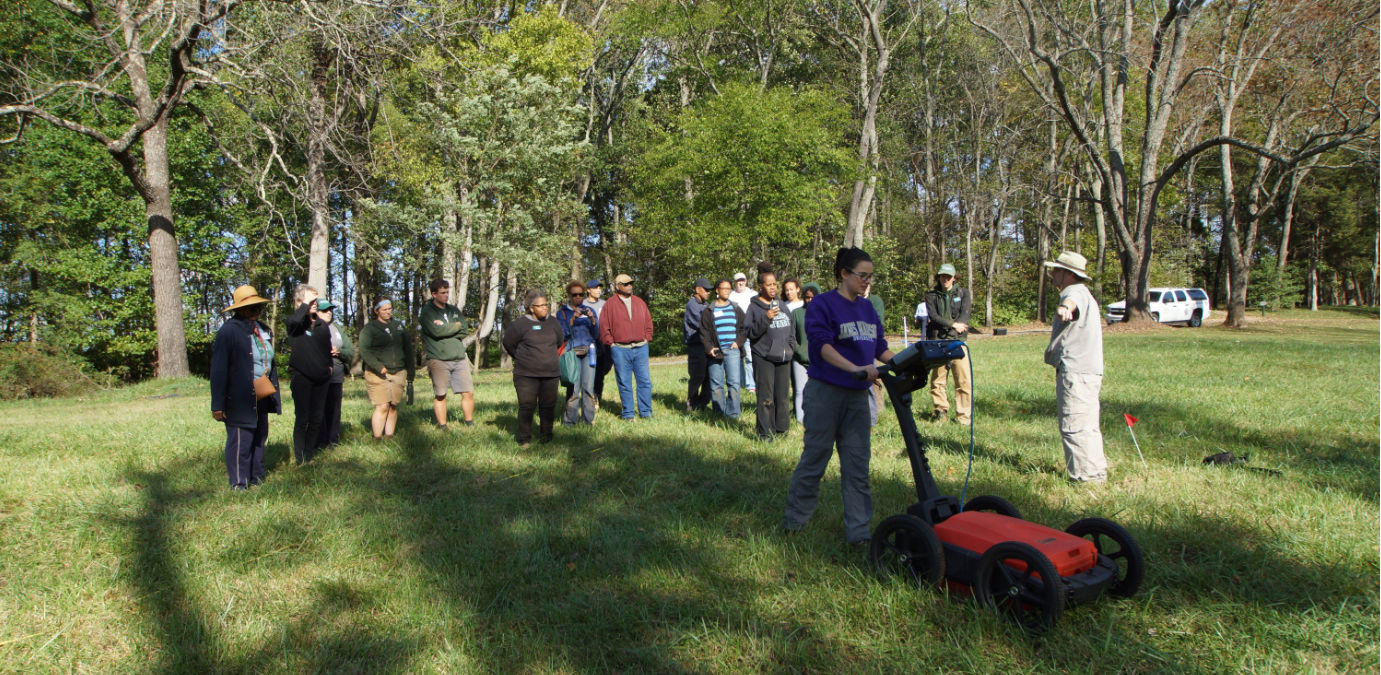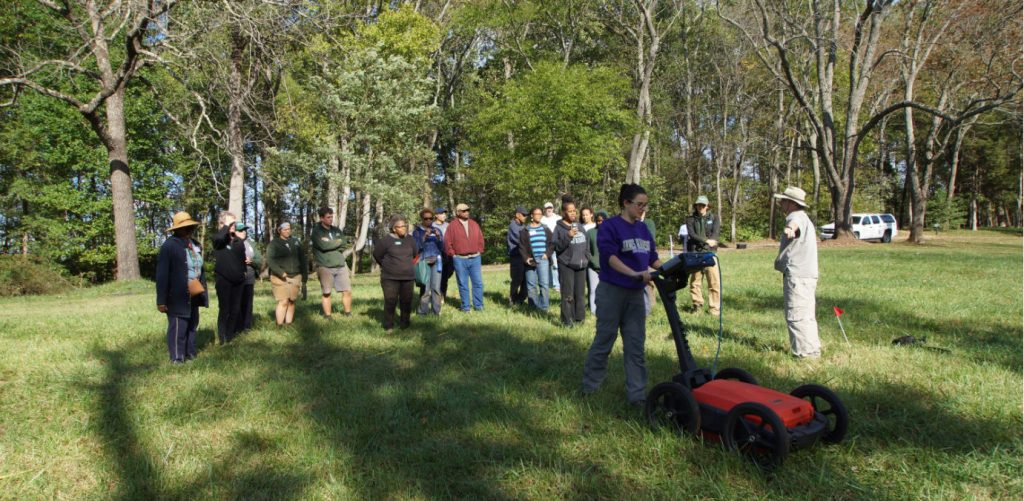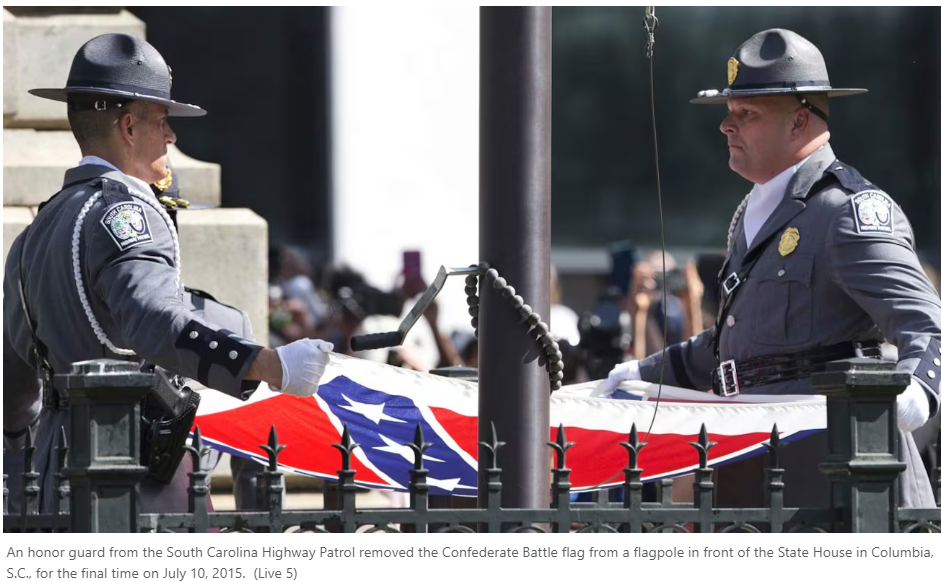VIRGINIA: James Madison Dig Reveals Slave Evidence
At James Madison’s sprawling Montpelier estate, geophysicist Shane McGary and student Michelle Proulx take turns pushing what looks like a lawn mower across fields peppered with horse patties. Below the device, a 400-megahertz pulse of electromagnetic radiation continually sweeps the earth. When the radar hits something interesting, a muddled, staticky curve appears on a display of the machine’s handle bars.
North to south they move, looking for evidence about those who inhabited this land alongside the fourth president of the United States. More specifically, they’re looking for bodies that have been buried from east to west.
“The enslaved generally were buried with their feet facing east so they could get up and walk back to Africa,” McGary says. “So they could walk back home.”
Madison, the former owner of this land and an author of the Constitution’s Bill of Rights, once wrote: “We have seen the mere distinction of colour made in the most enlightened period of time, a ground of the most oppressive dominion ever exercised by man over man.”
He was also a slave owner. At Madison’s death, about 120 men, women and children were enslaved at Montpelier. This aspect of his life has long been treated as a sort of inconvenient curiosity – a footnote in the biography of one of history’s great champions of liberty. Now at Montpelier, spurred by an active group of slave descendants, the work of McGary and Proulx is part of a larger effort to reclaim this place, not just as the home of James and Dolley Madison, but to six generations of enslaved people – people who built Montpelier, lived here, toiled here, loved here, died here and grieved here.
In winter at Montpelier, light snowfall marks depressions in the woods, just down a dirt path from the visitors center, and a few hundred yards from Madison’s house. Some of the depressions are marked with simple quartzite headstones.
“People had always seen them and assumed there were Civil War soldiers buried there just because the plantation and slavery wasn’t on people’s minds,” Montpelier archaeologist Matthew Reeves says.
During the early 20th century, the du Pont family, one of America’s richest, owned the property. When Montpelier researchers began collecting oral history from former du Pont workers for a new exhibit, they heard stories of workers uncovering human bones while plowing a field, along with tales of femur-wielding children chasing each other around for scares. When Reeves heard the same site referenced more than once by different sources, he began to suspect that these were more than just ghost stories.
One site in particular, now partially covered by a park road, came under special consideration as a possible forgotten slave cemetery. It wasn’t far from the depressions in the ground that were then already known. Last year, when Reeves brought cadaver-sniffing dogs to investigate the claims, the stories grew more plausible. That’s when he called on McGary, who works at James Madison University. Over weekends throughout the summer and fall, McGary been scouring the property with ground-penetrating radar.
McGary’s investigation site is only a short walk from the Madison family cemetery. And though that plot has been lovingly restored and maintained by the National Trust for Historic Preservation and groups such as the Daughters of the American Revolution, the slave cemeteries at Montpelier – like those throughout the South – have been largely neglected and forgotten over the decades.
“Part of the reason we do this is because its geophysics, and that’s what I do,” says McGary, who earned a PhD at the Massachusetts Institute of Technology for untangling the volcanic system of Mount Rainier in Washington state. “But part of it is also trying to kind of give voice to a community that was silenced. I think there’s a movement right now – sort of a recognition that these parks haven’t done the kind of job that they ought to be doing.”
There’s nothing to mark McGary’s site today, but two centuries ago or so, there was probably a funeral here. Perhaps it was at night so that friends and family from nearby plantations could join the ceremony. Here, the enslaved might have gathered as drumming and singing rose in the air around the grave of someone whose entire earthly life had played out, confined to this plot of land, the hazy Blue Ridge Mountains that marked the horizon as distant to them as the stars in the sky.
It’s not known who is buried in the graves picked up by McGary’s radar. For the most part, slaves’ lives were only haphazardly captured in letters and ledgers at Montpelier. One letter to Dolley Madison from the enslaved Sarah Stewart mentions a “Sylvie” dying in childbirth at Montpelier. But nothing else is known about her life, or the life of her child. A few – such as manservant William Gardener, whose mind, according to Madison, was “thoroughly tainted” by ideas of freedom while serving the congressman in Philadelphia, or Paul Jennings, who as a free man later in life helped out a destitute and widowed Dolley Madison with finances – managed to make the history books, but many of the names and lives of the enslaved at Montpelier were lost to time.
One October weekend, about two dozen people who are believed to be descendants of the slaves at Madison’s estate joined in the search for their ancestors. The Montpelier Foundation, which operates the site, has made a concerted effort in recent years to identify family members of the estate’s residents just as many descendants have embarked on personal journeys to connect to their long-shrouded past.
For Debra Mills, a Navy veteran who lives in Virginia Beach, Virginia, her experience with her fellow descendants of Montpelier’s slaves has been one of continual discovery. The last reunion led to her finding a new cousin. Mills’s great-great grandfather, George Gilmore, was once enslaved at Montpelier and later built a cabin on the property in the 1870s after emancipation. When the museum began restoration work on the cabin in the 2000s, Mills learned from her father, who slept in the cabin as a child, about her ancestry.
“We knew that there had to have been slaves in our background because of the way we look, but we didn’t know much about our history,” she says. “The elders in all of our families basically said, ‘We don’t talk about that. That’s too painful.’ “
She had joined McGary and Proulx in the search for her ancestors, calling the experience “bittersweet.” She couldn’t help being caught up in the excitement of the technology while also being sorrowed anew at the anonymous and forgotten bodies revealed below. Mills says she recognizes that, as the father of the Constitution, Madison laid the intellectual groundwork for her ancestors’ eventual emancipation, but she is bewildered by the capacity of most of the founders to espouse the virtues of liberty for society at large while practicing such inhumanity at home. Mills says she has seen echoes of this same inhumanity in her own lifetime.
“I will tell you when I saw it,” she says. “I was 12 years old in Farmville, North Carolina.”
Mills had grown up in Okinawa, Japan, in an Air Force family, and so was shielded from the racial apartheid of the South. After moving back to the United States as a child, and while visiting a family friend in the 1960s, Mills ran toward a water fountain in town.
“My dad was like, ‘No, no, no.’ And I said, ‘What?’ Then I looked and it said, ‘Colored only, whites only.’ I looked at him and I said, ‘What is ‘colored’?’ And he said, ‘Baby girl, that’s us.’ And I said, ‘What does that mean?’ And all the way back afterward he explained what I was going to have to face in my lifetime.”
Mills applauds Montpelier which has also restored a nearby train depot to its double-entrance Jim Crow appearance with separate signs for whites and blacks – illuminating the through line of history that connects each era to the one before.
“They’ve done something remarkable,” she says.
As the descendants gathered around the ground-penetrating radar on that October day, the crowd was shot through with an uneasy mix of nervous excitement and profound solemnity over what McGary and Proulx might find.
“You have to understand, I had my own moment as well,” Mills says about the high-tech search. “My husband was standing back and I went up and I looked at the machine. Everyone kind of moved out of the way because it’s a very small monitor that you’re looking at. But some people were also standing back because it was very emotional.”
McGary had called their attention to what might be the signature of a forgotten burial in the radar data, an unassuming fuzzy parabola bouncing back from the ground below.
“That may have been someone’s great-grandmother,” Mills says, her voice trembling with emotion. “And they would never know her name.”
–fredericksburg.com




